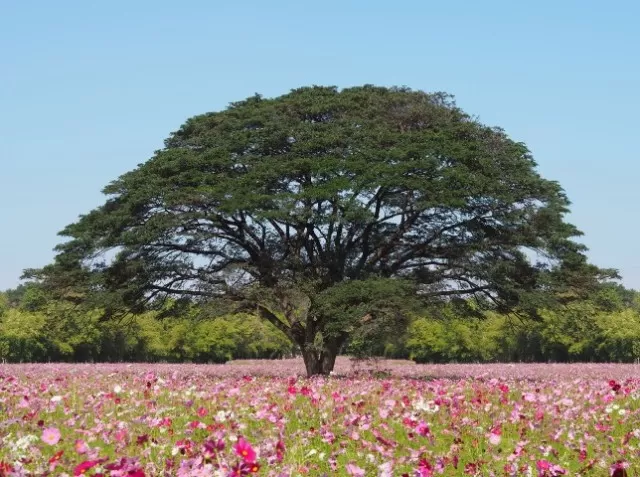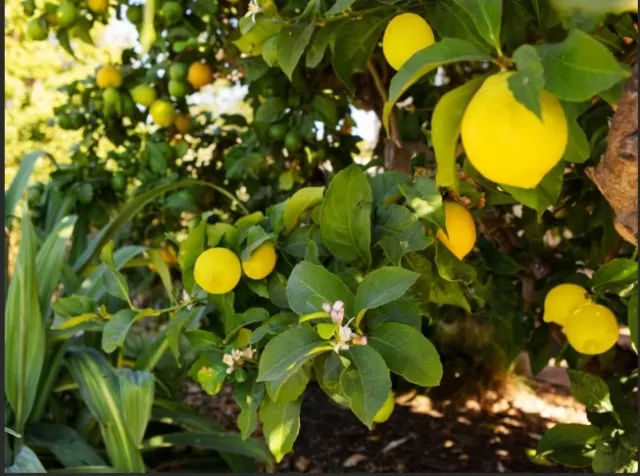Ideal Indoor Trees for Growing. Introducing potted trees to the interior of your home offers a captivating blend of color, texture, and even improved Air Quality. Contrary to common belief, many of these botanical beauties are simpler to care for than one might imagine. Prepare to uncover a selection of top tree contenders, each boasting unique shapes and sizes that seamlessly adapt to every room’s ambiance.
The infusion of potted trees into your living space creates a harmonious fusion of nature and design, transforming your home into a tranquil sanctuary. Not only do these trees add a splash of vibrant color and a touch of alluring texture, but they also play a role in purifying the air you breathe, contributing to a healthier indoor environment.
Delve into our carefully curated assortment of potted trees, each chosen for its suitability to various spaces within your home. Whether you’re seeking a compact accent piece or a statement tree to fill a larger room, you’re sure to discover an option that resonates with your aesthetic and practical preferences.
The Elegance of the Umbrella Tree: A Delicate Indoor Marvel

The umbrella tree, characterized by its slender stems adorned with elegant leaflets, thrives when exposed to vibrant, diffused sunlight.
Hailing from tropical origins, this remarkable indoor tree possesses the ability to attain considerable heights. Yet, by occasionally engaging in careful pruning, one can not only mold its growth but also maintain it at a comfortably controlled stature, ranging from approximately 4 to 8 feet.
The allure of the umbrella tree extends beyond its botanical traits.
When introduced as a solitary specimen, it serves as a captivating focal point, infusing any space with natural beauty. Alternatively, the option to cluster multiple umbrella trees together unveils an opportunity to craft a living partition, seamlessly merging functionality with aesthetics.
This living partition can be employed to foster an inviting sense of privacy or to tastefully divide a room into distinct, harmonious zones.
Whether chosen as a singular masterpiece or a collective ensemble, the umbrella tree promises to introduce an element of sophistication and vitality to any interior landscape.
Its graceful demeanor and adaptability make it a versatile companion for those who seek both the serene charm of nature and the artistic finesse of interior design.
The Prosperous Charm of the Money Tree: Cultivating Luck and Lushness
The Malabar chestnut, affectionately known as the money tree, stands as an age-old emblem of fortune and positive destiny.
Distinguished by its quintet of trunks elegantly woven together, this symbolic arboreal wonder demands consistent intertwining as its stature flourishes. Each braid signifies a convergence of history, culture, and the promise of thriving prosperity. .
Thriving in environments suffused with gentle, diffused illumination, the money tree revels in an ambiance of subtle radiance.
Its affinity for humidity makes it a coveted addition to spaces that boast sunlit windows, such as a rejuvenating bathroom retreat. Envision the fusion of auspicious blessings and verdant opulence within your decor—a blend of nature’s bounty and aesthetic refinement.
Hydration becomes an art when nurturing the money tree.
A judicious schedule of watering, averaging two to three times per month, is key, as these arboreal treasures despise standing in damp soil. Watch for signs—when the soil recedes to a dryness of 2 to 4 inches below the surface, the moment to quench its thirst arrives.
Guiding luminance is an essential dance for these trees of fortune.
Their preference for ambient, non-direct sunlight is a testament to their sensitivity. Exposure to harsh rays could result in leaves marked by sun’s embrace turned to scorched elegance.
Rooted well-being is safeguarded by an appropriate soil selection.
The money tree thrives best when nurtured in a well-draining commercial potting medium. An act of balance, this choice mitigates the risks of root rot while providing a foundation for the tree to flourish.
In the tapestry of nature and human connection, the money tree weaves a narrative of aspiration, enrichment, and the perpetual renewal of luck.
A living testament to the fusion of culture and cultivation, it beckons to those who seek to infuse their lives with a touch of opulence, a dash of serendipity, and an abundance of evergreen allure.
The Meyer Lemon Tree: A Compact Citrus Marvel for Year-Round Delights

Delve into the world of citrus wonder with the Meyer lemon tree, a diminutive yet robust variety that defies the conventional limitations of lemon trees.
This exceptional cultivar secures a place among the elite as one of the 10 Indoor Fruit Trees You Can Cultivate Year-Round at the sanctuary of your own home. Its versatility as an indoor companion, coupled with its resilience, sets it apart.
Revel in the promise of freshly grown lemons regardless of the seasons.
The Meyer lemon, renowned for its delicate stature, boasts a tenacity that surpasses many of its counterparts.
The allure lies not only in its hardiness but also in the promise of its harvest. Each thin-skinned fruit, a testament to its distinctiveness, carries a sweetness that eclipses the tang found in traditional lemon trees.
This attribute makes the Meyer lemon a treasure coveted by culinary enthusiasts, a dream come true for those who champion the allure of freshly sourced ingredients within arm’s reach.
An ode to the symphony of seasons, the Meyer lemon tree yearns for authentic sunshine to thrive.
Basking under the radiant touch of genuine sunlight, it blossoms during the warmth of summer. As the chill of winter beckons, it seeks sanctuary within the cozy embrace of indoor protection.
Quenching its thirst becomes an art, a dialogue conducted in harmony with the leaves themselves.
A sip every 1 to 2 weeks serves as nourishment, a reminder of the delicate equilibrium between hydration and well-being. The leaves, a living canvas, relay their messages—drooping leaves, an ode to overindulgence; dried and curled leaves, a plea for moisture.
Radiance is the essence of this tree’s existence.
An orchestra of flowering and fruiting demands an abundance of luminance, a minimum of 6 hours per day. The southern window reigns supreme, granting the tree its daily quota of solar sustenance.
For its roots to thrive and its fruits to flourish, the Meyer lemon tree craves the companionship of the right soil.
A specialized citrus potting mix rises to the occasion, an alchemical concoction designed to deliver the nutrients required to birth luscious fruit. This blend not only serves as nourishment but as an invitation, beckoning the tree to unleash its full potential.
The Meyer lemon tree stands as an embodiment of horticultural finesse and culinary delight.
Its petite form conceals a spirit that thrives beyond expectations, gifting both seasoned gardeners and novices with the joy of nurturing a miniature orchard, a testament to nature’s boundless beauty, and a constant reminder of the art of savoring life’s simplest pleasures.
Dracaena: The Enchanting Dragon Tree Bringing Whimsy Indoors
Welcome to the realm of dracaena, a versatile and captivating plant also known as the dragon tree.
This botanical marvel holds a coveted spot in the decorator’s toolkit, offering an abundance of aesthetic charm with minimal maintenance demands. Its unhurried growth allows it to ascend to heights of up to 6 feet within indoor sanctuaries. Bedecked with a cascade of spiky leaves, the dracaena exudes a whimsical quality reminiscent of the imagination of Dr. Seuss himself, bestowing a touch of fantastical allure upon modern interiors.
A living testament to nature’s fusion of elegance and playfulness, the dracaena emerges as a beacon of creativity in indoor decor.
Standing as one of the preeminent potted tree choices for interior spaces, its repertoire encompasses a plethora of captivating variations, each radiating its own unique personality.
Nurturing the dracaena is a delicate dance of hydration, a symphony that strikes a balance between moisture and restraint.
The roots relish moist soil, yet abhor the stagnation of waterlogged conditions. A weekly or bi-weekly watering schedule, responsive to the plant’s needs, preserves this equilibrium.
The secret lies in allowing the soil to breathe, ensuring it dries out between drinks. To pamper this elegant denizen of green, purified or distilled water stands as the preferred elixir.
Illumination serves as the dracaena’s source of vitality and artistry.
Enthralled by filtered luminance, it flourishes under the caress of gentle, bright light. An entrancing paradox, it emerges as one of the 10 Trees That Thrive in Low-Light Indoors, demonstrating a resilience that defies convention.
Yet, direct sunbeams can transform from nurturing embrace to scorching hazard, with leaves tarnished in brown before falling away.
Soil, the foundation of all horticultural dreams, plays a pivotal role in the dracaena’s prosperity.
A substrate enriched with organic nourishment lays the groundwork for its splendor to unfold. This tribute to the soil’s composition is the bedrock upon which the dracaena flourishes, capturing the essence of vitality that is then translated into its remarkable foliage.
The dracaena, a botanical symphony resonating with whimsy, intrigue, and grace, beckons to those who seek to harmonize nature with artistic expression.
Its stature transcends mere plant-keeping, evolving into a dialogue between the botanical and the human spirit—a story of growth, vibrancy, and the shared journey of nurturing life.
Fiddle-Leaf Fig: Graceful Elegance Amidst the Genus Ficus

Within the expansive realm of the Ficus genus, the fiddle-leaf fig emerges as a distinguished member, capturing hearts with its grandeur and individuality.
Distinct from its fellow houseplant counterparts, the fiddle-leaf boasts leaves of considerable size, a feature that, when coupled with its elegant branching architecture, has catapulted it into the forefront of indoor greenery. As if conducting a symphony of sophistication, this arboreal wonder has flourished ubiquitously, gracing spaces with its natural allure.
Elegance meets intricacy in the fiddle-leaf fig, a captivating emblem that resonates deeply within the horticultural tapestry.
Its majestic leaves, resembling the curves of a violin, infuse a unique charisma that resonates within modern interiors. This visual masterpiece, however, is no ordinary companion—it is endowed with a temperament that demands understanding and precision.
This indoor arboreal treasure thrives under a regimen of care that cherishes subtlety.
The fiddle-leaf fig shies away from the direct touch of sunlight, and its roots abhor excess moisture. Meticulous attention is necessary when cultivating its well-being.
Delicately dancing between water and restraint, it requires a consistent and moderate water supply. As the tree’s height extends, so does its thirst—a nurturing ritual that begins with an estimate of 1 cup per week, then magnifies with each additional foot in stature.
The practice of allowing excess water to drain is paramount, shielding the fiddle-leaf fig from the perils of waterlogged roots.
Natural light becomes a vital chapter in the fiddle-leaf fig’s story.
It longs for the caress of ample sunlight, a preference that permits you to proudly place it in direct view of a window, absorbing nature’s luminous bounty.
Soil, the foundation of prosperity, is a carefully chosen blend for the fiddle-leaf fig.
A well-draining concoction, enriched with organic essences, becomes the cradle for its roots. The ideal composition combines peat-based soil with perlite, inviting a balance that mirrors the equilibrium nature intends.
To invite the fiddle-leaf fig into your space is to embrace the fusion of nature’s majesty and intricate human stewardship.
This botanical masterpiece harmonizes beauty with challenge, grace with diligence—a reflection of life itself. It stands as a testament to the endless journey of nurturing and the art of coexisting with the remarkable world of flora.
*The information is for reference only.